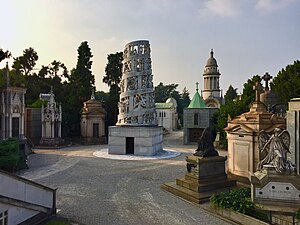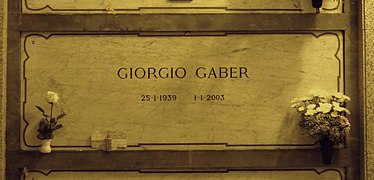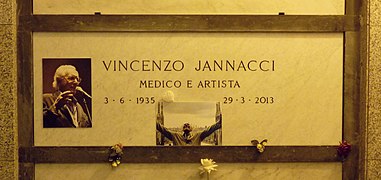Cimitero Monumentale di Milano
| Cimitero Monumentale di Milano Monumental Cemetery of Milan | |
|---|---|
 Main entrance | |
 | |
| Details | |
| Established | 1 January 1867 |
| Location | |
| Country | Italy |
| Coordinates | 45°29′09″N 9°10′45″E / 45.485831°N 9.179056°E |
| Type | Non-denominational |
| Owned by | City of Milan |
| Size | 25 hectares (62 acres) |
| Website | Monumental Cemetery |
The Cimitero Monumentale (Italian: [tʃimiˈtɛːro monumenˈtaːle] "Monumental Cemetery") is one of the two largest cemeteries in Milan, Italy, the other one being the Cimitero Maggiore. It is noted for the abundance of artistic tombs and monuments.
Designed by the architect Carlo Maciachini (1818–1899), it was planned to consolidate a number of small cemeteries that used to be scattered around the city into a single location.
Officially opened in 1866, it has since then been filled with a wide range of contemporary and classical Italian sculptures as well as Greek temples, elaborate obelisks, and other original works such as a scaled-down version of the Trajan's Column. Many of the tombs belong to noted industrialist dynasties, and were designed by artists such as Adolfo Wildt, Giò Ponti, Arturo Martini, Agenore Fabbri, Lucio Fontana, Medardo Rosso, Giacomo Manzù, Floriano Bodini, and Giò Pomodoro.
The main entrance is through the large Famedio, a massive Hall of Fame-like Neo-Medieval style building made of marble and stone that contains the tombs of some of the city's and the country's most honored citizens, including that of novelist Alessandro Manzoni.
The Civico Mausoleo Palanti designed by the architect Mario Palanti is a tomb built for meritorious "Milanesi", or citizens of Milan. The memorial of about 800 Milanese killed in Nazi concentration camps is located in the center and is the work of the group BBPR, formed by leading exponents of Italian rationalist architecture that included Gianluigi Banfi.
The cemetery has a special section for those who do not belong to the Catholic religion and a Jewish section.
Near the entrance there is a permanent exhibition of prints, photographs, and maps outlining the cemetery's historical development. It includes two battery-operated electric hearses built in the 1920s.
The Jewish Section
[edit]The section, designed by Carlo Maciachini, opened in 1872 to replace the cemeteries of Porta Tenaglia, Porta Magenta, and Porta Vercellina. It lies east of the Catholic cemetery and has a separate entrance. The area is the result of a 1913 expansion to the southern and east. The central building was originally the entrance to the cemetery.
Tomb numbering is repeated because the cemetery is divided into six fields and an addition in the eastern side. There are also three common fields, including one for children, where burials date from 1873 to 1894, with small gravestones on the ground bearing the names and dates of death.
The monuments, built from 1866 onward, are located along the walkways. There are also family shrines, two of which were designed by Maciachini, columbaria, and ossuaries along the northern and western cemetery walls and burials in the central building. There are 1778 burials, some in memory of people killed by in Nazi concentration camps or in the Lake Maggiore massacres, including at Meina.
There are many monuments of artistic value built by important architects and sculptors, described in the guide book by Giovanna Ginex and Ornella Selvafolta .[1]

The following architects have worked in the Jewish section: Carlo Maciachini (Davide Leonino and Pisa shrines), Giovanni Battista Bossi (Anselmo de Benedetti tomb), Ercole Balossi Merlo (Leon David Levi shrine), Luigi Conconi (Segre shrine), Giovanni Ceruti (Vitali shrine), Carlo Meroni (Taranto tomb), Cesare Mazzocchi (Giulio Foligno shrine), Manfredo d'Urbino (Jarach shrine, Mayer tomb, Besso tomb, Monument to the Jewish Martyrs of Nazism), Gigiotti Zanini (Zanini tomb), Adolfo Valabrega (Moisé Foligno shrine), Luigi Perrone (Goldfinger shrine). Sculptors whose work is found here include: Mario Quadrelli (Pisa shrine), Giuseppe Daniele Benzoni (Ottolenghi Finzi tomb), Luigi Vimercati (Estella Jung tomb), Agostino Caravati (Alessandro Forti tomb), Rizzardo Galli (Vittorio Finzi tomb), Enrico Cassi (De Daninos tomb), Attilio Prendoni (Errera and Conforti tomb), Eduardo Ximenes (Treves shrine), Giulio Branca (Giovanni Norsa tomb, Michelangelo Carpi tomb), fratelli Bonfanti (Davide and Beniamino Foà tomb), Enrico Astorri (Carolina Padova and Fanny Levi Cammeo tomb), Egidio Boninsegna (Giuseppe Levi tomb), Dario Viterbo (Levi Minzi columbarium), Giannino Castiglioni (Ettore Levis and Goldfinger tombs), Adolfo Wildt (Cesare Sarfatti tomb), Eugenio Pellini (Bettino Levi tomb), Arrigo Minerbi (Renato del Mar tomb), Roberto Terracini (Nino Colombo tomb).[2]
The central building was enhanced in May 2015 with artistic windows that represent the Twelve Tribes of Israel by the artist Diego Pennacchio Ardemagni.[3]
Crematorium
[edit]
The cemetery contains the Crematorium Temple, which was the first crematorium to open in the Western world. The crematorium opened in 1876 and was operational until 1992. The building is also a columbarium.[4][5][6] As with other early crematoria in Italy, it was built in Greek Revival architecture.[4]
Famous graves
[edit]


Signals located throughout the cemetery point visitors to several of the most remarkable tombs and monuments. Some of the persons interred in the cemetery include:
- Alberto Ascari (1918–1955), Formula One champion driver
- Alberto Lattuada (1914–2005), director
- Alessandro Manzoni (1785–1873), poet, novelist, considered the founder of modern Italian language; tomb located at the very center of the Famedio
- Alda Merini (1931–2009), poet
- Amilcare Ponchielli (1834–1886), composer
- Anna Kuliscioff (1857–1925), political activist
- Antonio Ascari (1888–1925), Grand Prix champion driver
- Antonio Bernocchi (1859–1939), industrialist
- Arrigo Boito (1842–1918), composer, librettist
- Arturo Toscanini (1867–1957), conductor and cellist
- Bruno Munari (1907–1998), artist
- Camilla Cederna (1911–1997), editor, writer
- Camillo Boito (1836–1914), architect
- Candido Cannavò (1930–2009), journalist
- Carla Fracci (1936–2021), ballet dancer
- Carlo Cattaneo (1801–1869), philosopher, patriot
- Cesare Maldini (1932–2016), football player
- Dario Fo (1926–2016), 1997 Nobel Prize in Literature
- Domenico Induno (1815–1878), painter
- Emilio Longoni (1859–1932), painter
- Enzo Jannacci (1935–2013), singer-songwriter
- Ernesto Bazzaro (1859–1937), sculptor
- Filippo Filippi (1830–1887), journalist, music critic
- Filippo Tommaso Marinetti (1876–1944), poet and main founder of the futurist movement
- Filippo Turati (1857–1932), politician
- Franca Rame (1929–2013), political activist, actress
- Francesco Hayez (1791–1882), painter
- Francesco Maria Piave (1810–1876), librettist, poet
- Franco Corelli (1921–2003), opera tenor
- Franco Moschino (1950–1994), fashion designer
- Gae Aulenti (1927–2012), architect
- Gaspare Campari (1828–1882), drink maker
- Gianroberto Casaleggio (1954–2016), entrepreneur, political activist
- Giangiacomo Feltrinelli (1926–1972), publisher, businessman
- Gino Bramieri (1928–1996), comedian and actor
- Gio Ponti (1891–1979), architect, industrial designer, artist
- Giò Pomodoro (1930–2002), artist
- Giovanni Pesce (1918–2007), communist partisan
- Giovanni Treccani (1877–1961), publisher
- Giulio Mongeri (1873–1951), architect
- Giulietta Pezzi (1810–1878), writer
- Giorgio Gaber (1939–2003), singer-songwriter, comedian
- Giorgio Gaslini (1929–2014), jazz pianist, composer, conductor
- Giuseppe Meazza (1910–1979), football player and manager
- Giuseppe Palanti (1881–1946), painter
- Herbert Kilpin (1870–1916), founder of A.C. Milan football club
- Leo Valiani (1909–1999), writer, politician
- Lelio Basso (1903–1978), politician
- Lina Merlin (1887–1979), politician
- Luca Beltrami (1854–1933), architect
- Luigi Giussani (1922–2005), priest, founder of "Communion and Liberation"
- Magda Olivero (1910–2014), opera soprano
- Mario Palanti (1885–1978), architect
- Mario Tiberini (1826–1880) and his wife Angiolina Ortolani-Tiberini (1834–1913), opera singers.
- Medardo Rosso (1858–1928), sculptor
- Piero Sacerdoti (1905–1966), insurer
- Philippe Daverio (1949–2020), art historian
- Rosa Chiarina Scolari (1882–1949) Mother Superior who helped the Italian resistance movement
- Salvatore Quasimodo (1901–1968), 1959 Nobel prize in Literature
- Temistocle Solera (1815–1878), poet, opera composer, librettist
- Ulrico Hoepli (1847-1935), publisher, founder of Hoepli Editore
- Valentina Cortese (1923–2019), actress
- Vladimir Horowitz (1903–1989), pianist
- Walter Chiari (1924–1991), actor
Mayors of Milan
- Aldo Aniasi (1921–2005), Mayor (1967–76)
- Angelo Filippetti (1866–1936), Mayor (1920–22)
- Carlo Tognoli (1938–2021), Mayor (1976–86)
- Emanuele Greppi (1853–1931), Mayor (1911–14)
- Emilio Caldara (1868–1942), Mayor (1914–20)
- Gino Cassinis (1885–1964), Mayor (1961–64)
- Giulio Belinzaghi (1818–1892), Mayor (1867–84; 1889–92)
- Marco Formentini (1930–2021), Mayor (1993–97)
- Virgilio Ferrari (1888–1975), Mayor (1951–61)
Gallery
[edit]-
Mausoleum of Antonio Bernocchi by Giannino Castiglioni (1930s)
-
The Last Supper, Campari family tomb
-
Arturo Toscanini's tomb
-
Morgagni family monument
-
Cemetery section from above
-
Ossuary
-
Arcades
-
Galleries
Other famous graves
[edit]-
Dario Fo and Franca Rame
See also
[edit] Media related to Cimitero Monumentale (Milan) at Wikimedia Commons (Gallery)
Media related to Cimitero Monumentale (Milan) at Wikimedia Commons (Gallery) Media related to Cimitero Monumentale (Milan) at Wikimedia Commons (Category)
Media related to Cimitero Monumentale (Milan) at Wikimedia Commons (Category)- Monumental Cemetery of Staglieno, in Genoa
- Certosa di Bologna, the site of the city's monumental cemetery
- Monumental Cemetery of Bonaria in Sardinia
- List of burial places of classical musicians
References
[edit]- ^ Giovanna Ginex, Ornella Selvafolta, The monumental cemetery of Milan’’, Silvana Editore, 1999
- ^ A description in Italian of major tombs and their artists can be found in the online guide to this section-
- ^ Inaugurato il nuovo tempietto al Monumentale
- ^ a b "Typology: Crematorium". Architectural Review. 14 November 2016. Retrieved 11 October 2019.
- ^ Boi, Annalisa; Celsi, Valeria (2015). "The Crematorium Temple in the Monumental Cemetery in Milan". In_Bo. Ricerche e Progetti per Il Territorio. 6 (8). doi:10.6092/issn.2036-1602/6076.
- ^ Encyclopedia of Cremation by Lewis H. Mates (pp. 21–23)

















